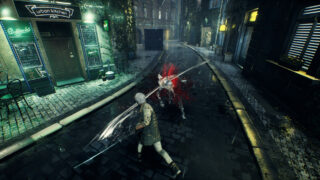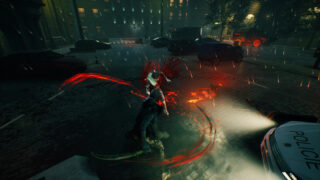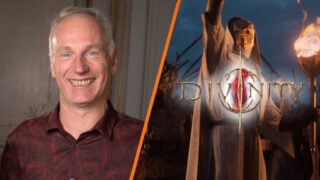Vampire Bloodhunt Interview: ‘No one wants to work on a pay-to-win game’
Sharkmob’s director and producer discuss the future of their stylish and brutal PS5 and PC battle royale

Vampire The Masquerade: Bloodhunt, a new free-to-play battle royale game set in the universe of the pen and paper RPG, launches today after several months of early access.
Unlike the early launch which only arrived on PC, this 1.0 version comes to both PC and PS5.
A stylish and brutal battle royal, players compete against 48 other vampires in solo or trios mode in order to be the last vampire standing, with the help of guns, swords and anything else they can get their hands on.
Ahead of the launch, we got the opportunity to sit down with the game’s director Craig Hubbard and Bloodhunt’s producer David Sirland to discuss the pitfalls of live games, and where they see Bloodhunt existing in the battle royale space.
Craig Hubbard, a development veteran, spent most of the mid-2000s working on the FEAR series as its creative director. He also served as lead game designer on Gotham City Imposters, a multiplayer title which saw teams of players dressed as iconic Batman characters do battle in a stylised Gotham.
With both multiplayer and horror experience under his belt, he’s a perfect fit for this unconventional vampire royale.
David Sirland joined Sharkmob after working at DICE on the Battlefield series for over a decade. Serving as a multiplayer producer on 2018’s Battlefield V, he left dice and the PvP traditional multiplayer space to helm Bloodhunt beginning in 2020.
How has developing Bloodhunt during the pandemic presented challenges?
David Sirland: I was at the office two days, and then it hit, and you know, work from home mandates and all that sort of thing. And that was interesting, coming into a new team being the leader, essentially of the team that took way longer than I would like it to have taken. So that was an interesting challenge. But it also comes with a lot of interest.
I got to know way more of the team more quickly than normal, like the people who actually interact with you first physically by walking around are the people you know first, and that tends to be the people that are very talkative, and so on. But now it’s more like we’re forced to interact with everyone and figure out what makes them tick and all that sort of thing. So I feel that’s the big thing here. But anyway, personally, I think making a free to play multiplayer title, which I’ve never done before, is super interesting.
How does working on a free to play title like Bloodhunt compare to the other games you’ve worked on during your career?
Craig Hubbard: The the most fun experiences I’ve had in my career have been working on PvP games. I think probably the most fun was a game called Gotham City imposters, which was sort of a similar situation where you take an IP that you don’t really associate with PvP, and you make a game out of it. But that was half the fun. PvP is just super fun to work on because it’s really fun to play.
You play test every day, you have the team incredibly invested. Because when you make a single-player game, the team will play it kind of reluctantly, and they won’t give you much feedback. But when they’re playing PvP, like any little thing that gets them killed, you hear about it. So you get great feedback from the team great involvement and investment, lots and lots of ideas. It’s really, really fun.
DS: I think the biggest difference is that you have to consider the motivations of players more, right? Because you essentially can get unlimited players to come in as long as your download client is small enough, they will all try it. But they’re also super disloyal because you know, they didn’t pay anything for it. They’re not invested yet.
So you have to have a really good onboarding, obviously. You also need to function as good social glue, which is what we’re going for. We’re trying to make a game where someone that is the early adopter comes in and says, ‘this is a cool game, I want my friends to come’, and then they play together. That will be the ultimate goal here to have it grow through recommendation essentially, or someone is pulling them.
How are you going to grab players initially?
DS: I think initially, obviously, the game looks pretty stunning. I think that draws a lot of attention. It also is a very watchable game. It’s fun to watch this game. It’s fun to watch someone else play this game and then you want to try it. Then the actual core gameplay is good… I think that’s the key aspect here, you need the game to be good and fun to play, press buttons and things happen. And it’s fun. I think that’s the core.
And you know, when we start iterating and adding things here, it’s really key that that’s the central and stays on point. I heard a comment before that, “I played a lot of in Early Access, and we played this build that we’re launching with, the biggest difference here is not like blatantly obvious, but this feels so much better and I feel like when I have a fight, it’s fairer”. That’s the best feedback I can get. Because that means our tiny, tiny balance changes to how this core mechanic works paid off.
How is the game monetised?
CH: From the moment I came here, it was already understood that it was going to be purely about cosmetics. I don’t think there’s ever any consideration of pay to win sort of approach like that, that kind of thing. If you look at it purely from what works, what’s the best way to make money, you can do that. But nobody wants to work on pay-to-win. Frankly, it’s very hard to recruit for that. I mean, it would make sense for a vampire game to be vampiric, but it’s just not. It’s unpleasant.
So I think from the beginning, it was always understood that it was going to be optional, cosmetic monetization. You basically want to make content that people think is cool enough that they actually want to buy it and you also need to earn trust, you need to make people feel like their money is going to somebody that they don’t mind giving money to it’s like almost like they’re a patron in a way.
“Nobody wants to work on pay-to-win. Frankly, it’s very hard to recruit for that. I mean, it would make sense for a vampire game to be vampiric, but it’s just not. It’s unpleasant.”
DS: This game is not monetized through any sort of grey area, gameplay-ish sort of way at all. We said no to that because we want this game to be a game you can play competitively. It’s not necessarily a competitive title, but it’s competitive to where the last vampire standing essentially. So you need to not have a way to sort of skip the line here, which is where we said also fits pretty well with the whole masquerade and vampire styles and all of that.
It’s all vanity. There are two fantasies: the gameplay fantasy and the vampire fantasy of being a vampire and what type of vampire you want to be. Are you a seductive one, brutality focused one, and then trying to figure out what’s the next thing when it comes in, you know, in pop culture even? What’s the next cool thing to wear, I guess. And that will be how we monetise this game.
The game has more of a focus on narrative than many other games in the genre, how do you make sure players that want that element of the game can be satisfied but also account for players that just want raw gameplay?
DS: Absolutely. I think that’s super key. I mean, we need to be a platform for like, this is an entertainment service. Essentially, we need to be a platform for both those types, and obviously one of them might end up like one group of players is larger than the other and so, therefore, there will be more features for that type of player over time. But initially, we’re trying to start sort of vanilla, and be like, have a great starting point where we have a bunch of scenarios where this could lead, and which type of player prevails and what type of game this really becomes. Both of them have a place.

Obviously, games like this need to have a roadmap of content in order to satisfy players, but almost more importantly, you need to be able to react to what the player base wants. Is the roadmap flexible in this sense?
CH: I think with the roadmap, there are certain aspects of a game that take a lot of time to develop that you have to think about very well in advance. I think especially anything involving content is just building, it takes time. So you have to anticipate that a bit. But when it comes to features, and then mechanics, I think you want to be as reactive as possible to the community as people are playing the game, and they’re starting to see, it’s really when you play a game a bit, you start to see those opportunities and the things that start to annoy you.
And if you’ve overplanned your roadmap, you can’t react to that stuff and see end up with a game that gradually loses the audience’s interest. So we really tried to say; “We have ideas, of course, we have lots of things we could do. But we’ve really tried to keep our plans flexible, as much as possible.”
DS: I mean, that’s sort of the core of it of a service game. You can’t have one road ma, you need to have a bunch of scenarios that are likely or less likely, but you need a bunch of them. And then you start and there’s a roadmap attached to each of those, or an order of things at the very least, like where you can swap things out. And they’re sort of equal value. And everything comes with a cost and a different result or impact on something else.
For instance, one thing that tends to be true when you’re doing updates or development is you have a feature update, and then you have a content update. And the reason for that is… ‘here are all your programmers, they need to do this thing, and it’s hard, and it takes a lot of iterations, I need to focus on that’. And, ‘here’s all your content and artists, and they need to do that, and in between when they are doing, they fix bugs’… that sort of thing tends to happen, for instance, and if you can do that at a smaller scale, it’s all about finding those balances.
So it’s a constant sort of reassessment, and it can be quite stressful being part of the team if you’re not communicative around what’s happening and why either, even internally, and I feel like it’s really helpful that we can be as communicatively outwards.
How has your work on previous games influenced your time on Bloodhunt?
DS: I really liked this because this reminds me of when we did a test environment for a former Battlefield title, where essentially the big splinter community were invested because they wanted to. And I think when you have a new game that comes out, you get that from the get-go that’s like the start of it, you get the people that are really interested, and they’re obviously more susceptible to be interacting with you and give you more of their time and all that sort of leads to a back and forth and a win-win situation.
I really felt like there was no baggage, apart from the unconventional IP, and I feel like we’ve sort of moved past that with the people that had qualms about “is this really a game that fits this universe?” I mean, either they just fully embraced us and love us now or you’re there at least with us and like rooting for this to succeed, because they realise the potential for more people to come into the universe and this is a great entry point to be interested in the rest of all the super-rich stuff that is part of this world.
CH: The plan for Gotham City imposters was to make it a game as a service. It was very early and there weren’t a lot of those examples yet in the west, but I think when you’re making a game like this, it’s really fun to actually get to release a game and then to support it. And a lot of times what used to happen is companies would put out a game and if it didn’t turn into a mega-hit, they would just abandon it and it would die and that you spend years working on a game and to see it just wither away because the people with the money don’t want to invest in sustaining it until it can build an audience.
It’s tragic. But I think what’s happened is the industry has seen that a lot of games that have become super big successes are coming out of the mod space, or the indie space where the teams just stick with it. And they build the community. And they prove themselves, and they involve people. And then they grow something that now suddenly has mass appeal.

























